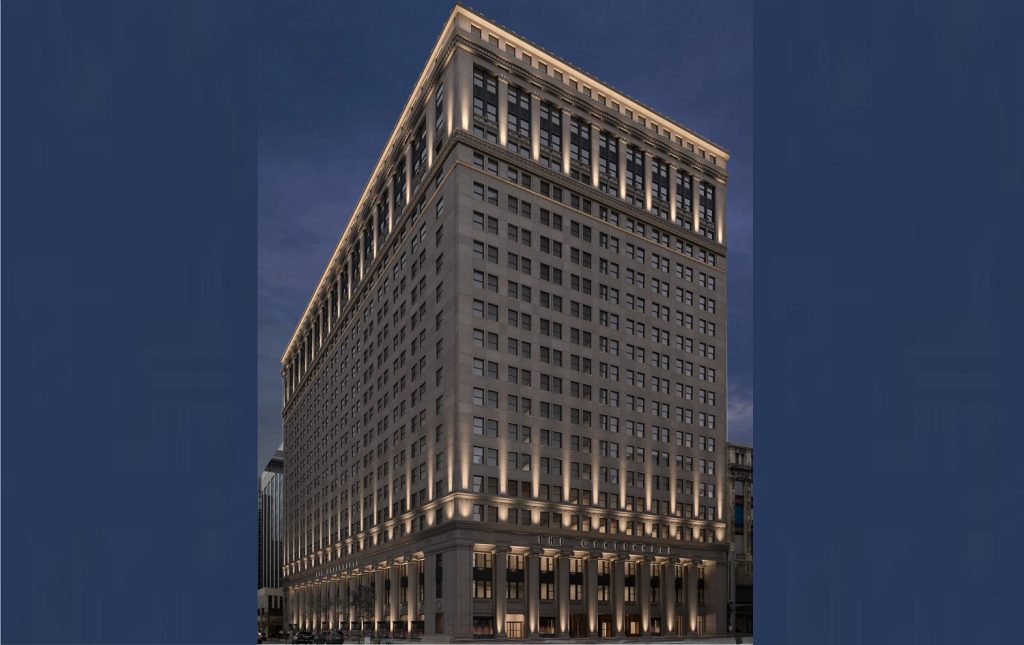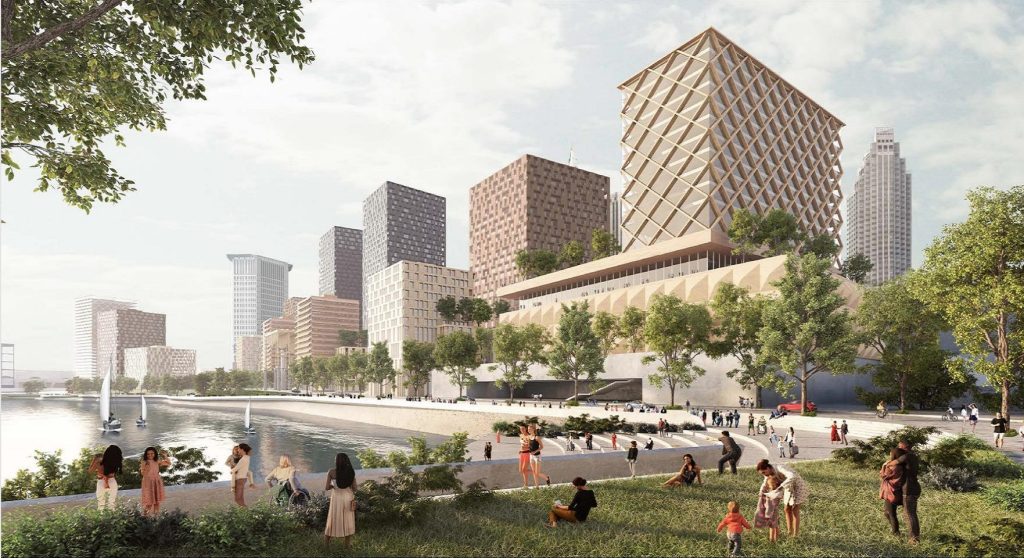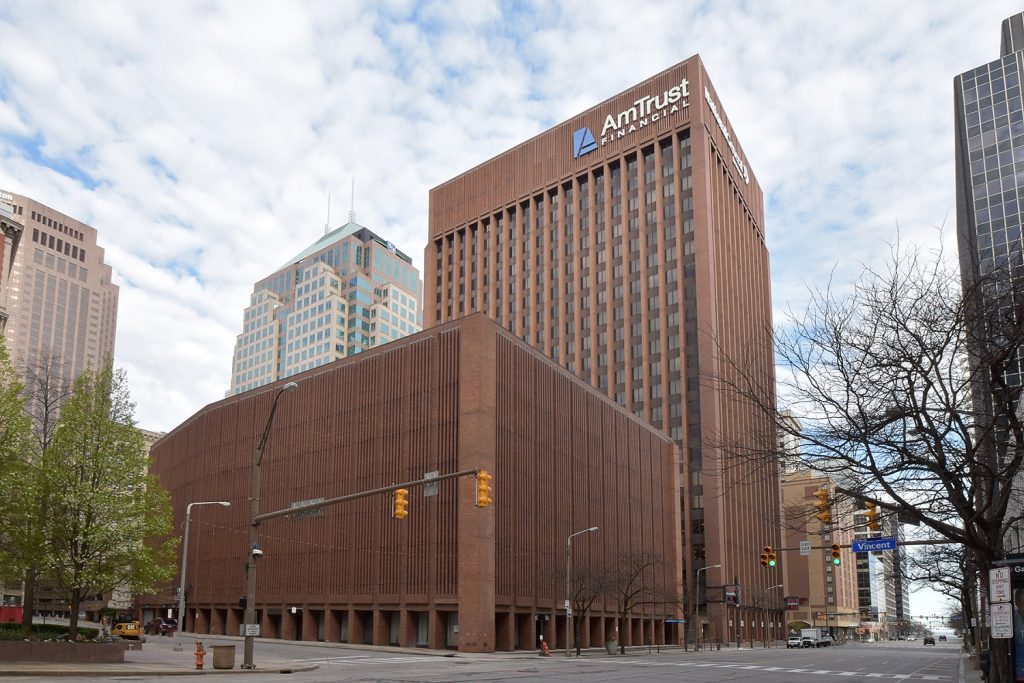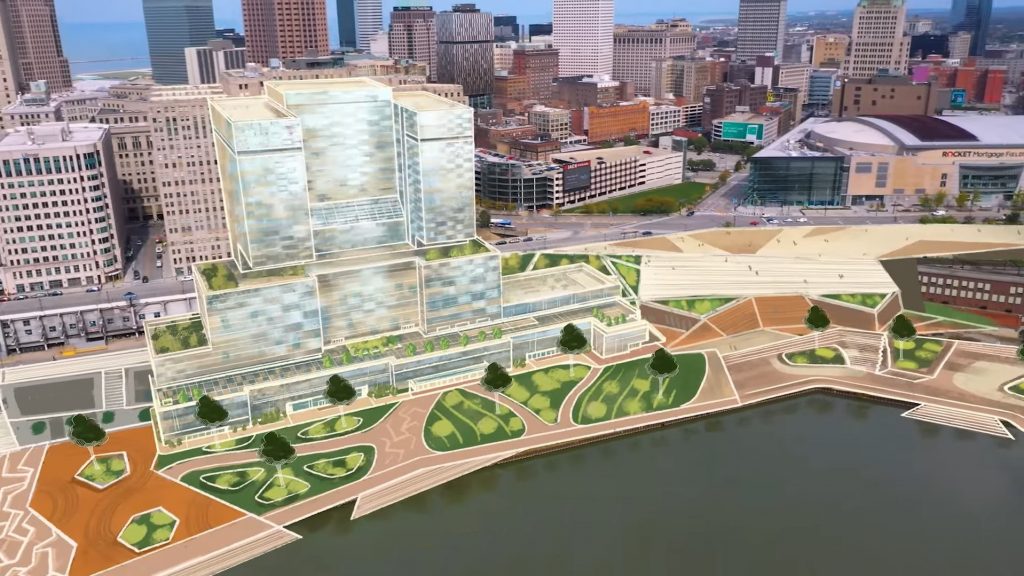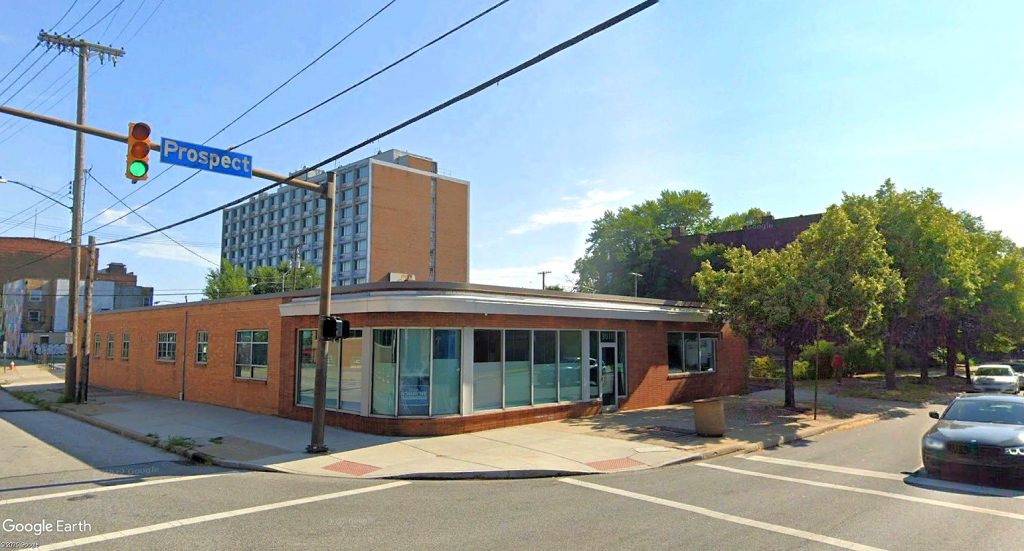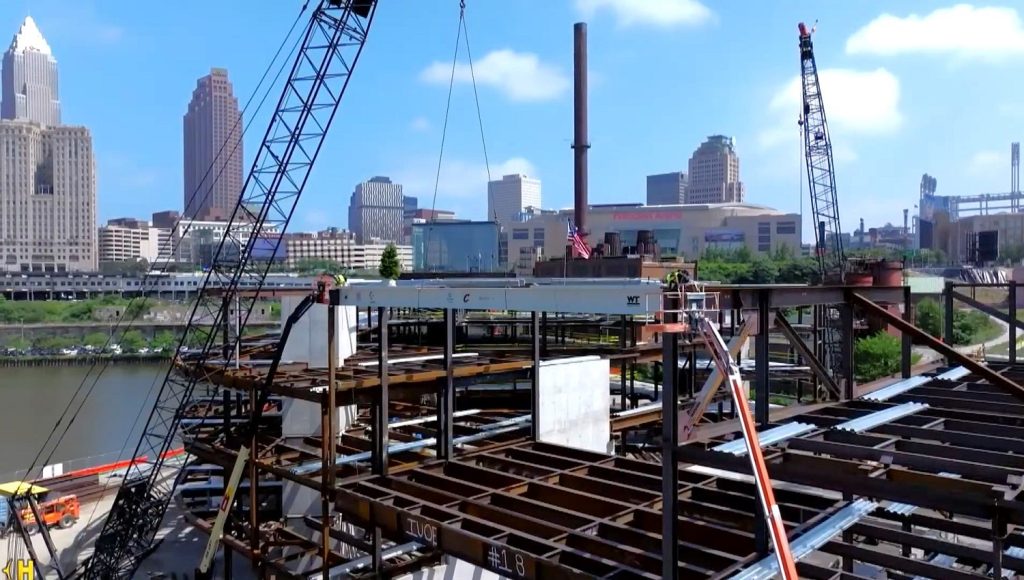
During a topping-off ceremony on July 8, crews set into place the last piece of structural steel (painted white) for the new Cleveland Clinic Global Peak Performance Center for the first phase of Bedrock Real Estate’s Riverfront Cleveland development. More projects on the riverfront and elsewhere downtown could be aided by increased public incentives in the two-year state budget passed June 30 (Bedrock). CLICK IMAGES TO ENLARGE THEM.
TMUD, OZ, CRA, Brownfields, historic programs boosted
When sifting through the many development incentives in the state’s newly passed two-year budget, it becomes clear that a lot of Cleveland urban core projects are going to be eligible for them and potentially benefit from them. But, as we saw from a state program to aid megaprojects, a program will only benefit a region if there are projects and their sponsors in that region who will apply for them.
That program, the Transformational Mixed Use Development (TMUD) tax credit, was a four-year experimental program championed by the late Ohio Senator Kirk Schuring of Canton who died of cancer last November. It was renewed, its credit cap increased from $100 million to $125 million and was extended indefinitely.
It and other changes were championed by the real estate and construction industries and by members of both the Ohio House and Senate. Those include Opportunity Zone (OZ) tax credits, Community Reinvestment Area (CRA) megaprojects, historic tax credits, parking garage subsidies and zoning referendum reform.
“The enactment of Ohio House Bill 96 delivers one of the most pro-growth operating budgets in the nation in terms of support of economic development in an overall tighter fiscal cycle,” wrote Michael Sikora III, board president of the real estate development association NAIOP of Ohio on its Web site.
“NAIOP members advocated for additional funding and refined standards for proven programs that provide the necessary tools to re-energize communities, attract private capital, and keep Ohio competitive for years to come,” he added.
There are a number of new-construction and renovation/repurposing projects in Downtown Cleveland, University Circle plus elsewhere in the city and its inner-ring suburbs that could benefit from these programs.
They include Bedrock Real Estate’s Riverfront Cleveland and Rock Block megaprojects, lakefront stadium site redevelopment, Justice Center redevelopment, Flats East Bank phase three, Project Scarlet conversion, Landmark Office Tower conversion, 800 Superior conversion, Ohio Savings conversion, Centennial and Rockefeller Building kick-starts, and more.
Previously, up to $80 million in TMUD tax credits were available per year to major-city projects and at least $20 million for general projects. To be eligible for a TMUD credit, a major-city project must be valued at $50 million or more, rise at least 15 stories high or measure more than 350,000 square feet among contiguous properties under ownership by the applicant.
General projects are eligible if they are new or at least 51 percent vacant and two or more stories tall or are at least 75,000 square feet among connected buildings. A TMUD cannot exceed 10 percent of the project’s costs. It is intended to fill a gap in existing project financing and the tax revenue generated by the project must exceed 10 percent of the development costs.
By increasing the maximum amount of TMUD credits awarded per year to $125 million, the Ohio General Assembly also increased the amount for major-city projects — those within 10 miles of a city having 100,000 or more residents — to $85 million.
Also, the legislature established a cap of $40 million available for all general projects. None had existed previously. The maximum award for any one project remains $40 million, according to the Ohio Legislative Services Commission.
Bedrock’s next phase of its Riverfront Cleveland development was the last Cleveland project to win a TMUD. In January, Bedrock’s Rock and Roll Land got a $9.1 million award but had requested the max $40 million credit.
Bedrock’s planned project is the first new-construction building of 15 or more stories in Downtown Cleveland to win, let alone seek, a TMUD. That, despite the TMUD program being sought by Cleveland-based Stark Enterprises to boost its new-construction nuCLEus high-rise megaproject, since replaced by Bedrock’s Rock Block.
Lawmakers and Ohio Gov. Mike DeWine also extended the OZ Tax Credit Program that was due to expire at the end of 2026 and doubled its annual cap to $50 million. Any any unused funds can be rolled over to the next award period to increase their utilization.

A potential megaproject or two could be involved in the replacement of the Justice Center — the boxy tower at center. A new courthouse could rise in the foreground off Lakeside Avenue while the existing Justice Center may be redeveloped with new uses but will likely require significant public assistance to advance it (Google).
The OZ program is intended to draw investment to historically distressed areas to support new construction and revitalization. The first application round for fiscal year 2025 opens today.
Ohio’s Brownfield Remediation Program, launched in 2021, was due to expire after awarding $716.9 million to 681 projects in 86 counties. Instead, lawmakers budgeted it with $200 million over the next two years and makes the program competitive and merit-based, rather than awarding funds on a first-come, first-served basis, Sikora said.
“Cleaning up contaminated sites removes the single biggest barrier to redevelopment, turning idle properties into productive assets that boost opportunities for investment,” he said.
Cuyahoga County and Cleveland in particular have done very well in landing Brownfield dollars. Projects like the redevelopment of Scranton Peninsula, Shoreway Tower, Warner and Swasey, Circle East and many others have benefitted from this program.
Another state program that got lawmakers’ attention and from which Greater Cleveland projects have been successful at winning awards is the Historic Preservation Tax Credit Program. Without this program, the many obsolete office buildings downtown would have remained vacant rather than be reinvigorated with housing, hotels and mixed uses.
Lawmakers raised the annual cap in tax credit awards from $60 million to $75 million, boosted the credit from 25 percent to 35 percent for projects in communities under 300,000 residents, and removed building vacancy as a practical requirement. Thus, owners do not have to ask tenants to leave prematurely.
Other, lesser-known programs also got a boost. A property tax exemption eligibility was created for multi-level, off-street parking structures that are owned, leased or constructed by a municipal corporation, a county, a new community authority, or a port authority, and the land they occupy.
Some developers have said the cost of building structured parking for urban developments has gotten unaffordable. According to Statista, the average cost to build each structured parking space equals or exceeds the average sale price of a new car today. So redevelopments like repurposing rapid transit station parking lots with parking decks and mixed uses could be eligible.
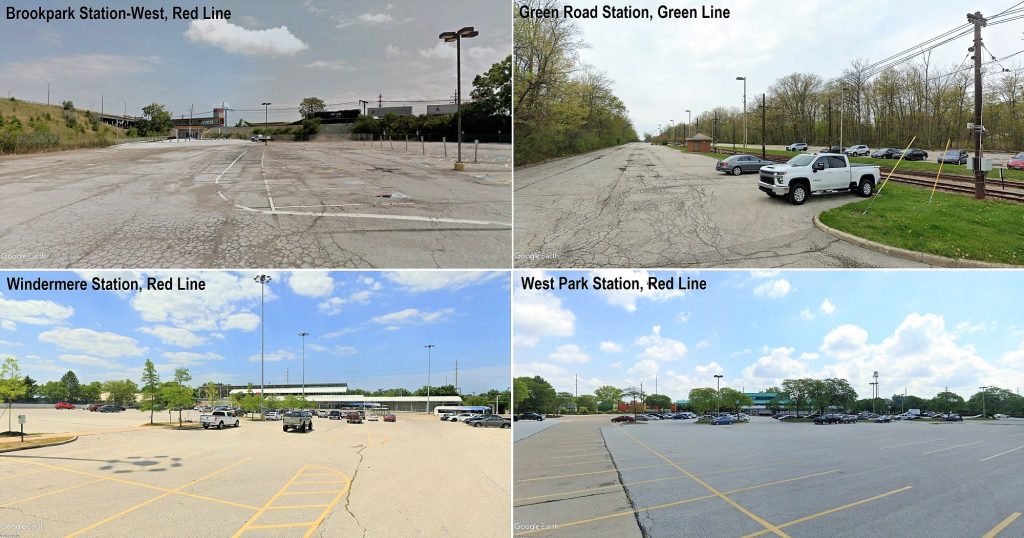
Since the pandemic, park-n-ride commuting to downtown on the Rapid has dropped significantly. But transit ridership between neighborhood-based stations remains steady. Increasingly, there is interest in developing unneeded land at stations with public-sector parking decks to support transit and mixed-use developments (Google).
“For developments that need creative solutions and true public-private partnerships, this will help make more projects financially feasible,” Sikora said.
State policy addressing Megaproject CRA was modernized. Megaprojects are those with a value of $1 billion or more. Legislators continued the 30-year tax exemptions for buildings tied to megaprojects or megaproject suppliers.
Lastly, lawmakers made it more difficult for citizens to force land rezoning measures to the ballot. The signature requirement to place local zoning referenda on the ballot increased from 10 to 35 percent of voters in municipalities and limited home rule townships. Developers sought this to improve predictability in their planning process.
“Each of these wins accelerates commercial real estate investment and job creation,” Sikora said. “As an organization, we believe these enhancements will lead Ohio in the direction of meaningful economic growth as a whole.”
END

